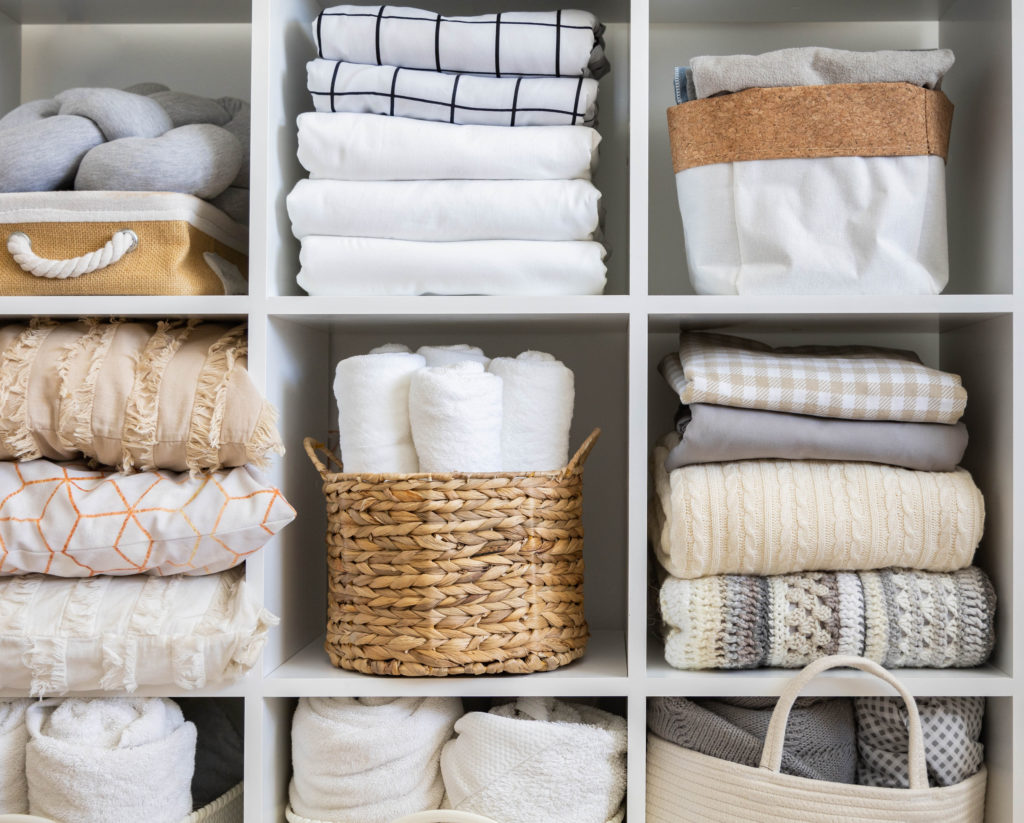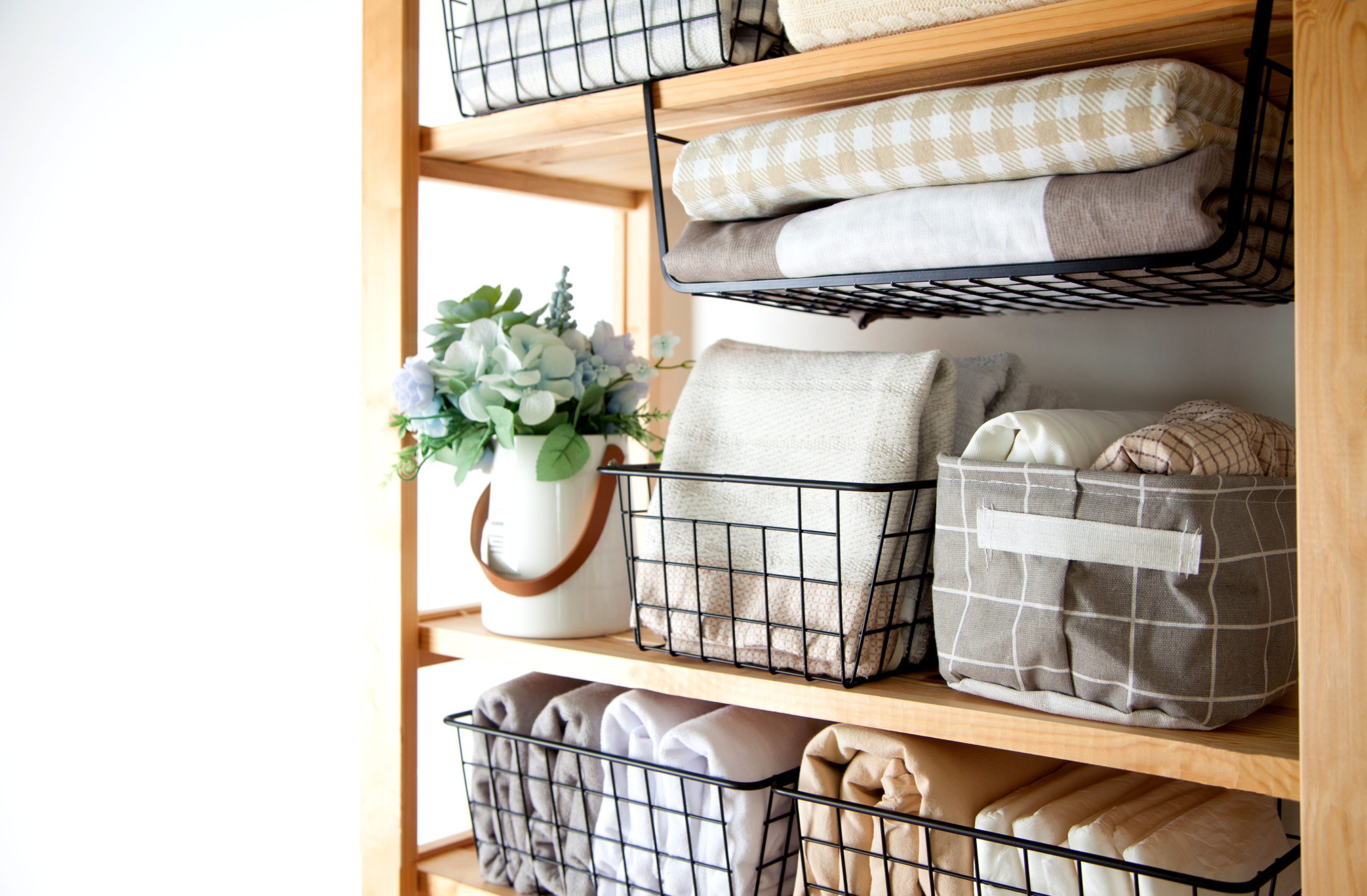I’ll admit right now that I am a fan of a good organizational bin. I find uses for them in every room, closet, and cedar cabinet in this apartment. I’m a particular fan of fabric ones with lids because stackables make use of our particularly tall shelves in our closets and utility room. BUT (you knew there was a “but,” didn’t you?) I’ve also fallen victim to the temptation of a colorful organizational bin before I knew my needs. If you want to learn from my mistakes, read on.
1 Have You Decluttered?
Before you buy an organizational bin, start by decluttering. On more than one occasion, I thought my problem was not enough storage, but really, the problem was too much stuff. This has been true of everything from wooly socks (yes, I live in Los Angeles, but wooly socks are still my weakness) to office supplies. So, if it has been a while before you assessed whether the stuff you want to store is still useful or something you love, take that time now before you buy something new.
2 What Products Need to be Stored?
I recommend not buying a single organizational bin before you know exactly what needs to be stored. For instance, I don’t love storing paint, cleaning chemicals, or other fluids in fabric storage containers. The risk of disaster or damage is just too great. Depending on the product, I prefer storing items like that in metal containers (like paintbrushes in my little red toolkit) or plastic. Baking ingredients are also better kept in glass jars, specialty tins, and, when necessary, plastic.
3 Does Your Storage Need to Be Open or Closed?
Are you trying to gather a bunch of tall snack packs for easy grabbing? Depending on the height of your shelves and the amount you are storing, you might be better served by a Paulownia wood organizational bin, particularly if you are looking for a sustainable option rather than a clear plastic bin.
I’m going to show you a couple of examples from Amazon. If you end up buying one, I might get a small commission.
iDesign Renewable Paulownia Wood Collection Storage Bin with HandlesThese wooden bins are open, and you can quickly grab and contain pantry products in them. We eat a lot of potatoes, and we need a better way to store them than in our refrigerator – the weight has cracked our refrigerator drawer. So, I’m seriously eyeing the open-front storage bin as an option.
This is the version on Amazon, I’m thinking about getting for the potatoes:
iDesign Renewable Paulownia Wood Collection Open Front Storage BinWhether you decide you need a clear plastic bin, an open wood storage bin, or a fabric cube with a lid, labels are going to be your friend. Yes, the open and transparent solutions allow you to see what is at eye level, but if the bins are above your eye level or closed, you may forget what you tucked away in the container. Also, labels help keep others in your household from randomly adding things to the wrong bin in their haste to put groceries away.
4 Does Your Organizational Bin Need Handles?
This is an easy one. If you are pulling bins from the depths of a shelving unit, you need an easy way to grab onto them. If you frequently move your storage container around your space, handles will make that easier. For example, if you keep your extra soft throw blankets in a coiled rope bin or woven storage container, you may want to move it when company arrives, you clean, or on laundry day. Handles will make that easier.

5 How Heavy is Your Stuff?
The first time I searched for a storage bin for our specialty paper, I thought one of my collapsible fabric bins would work brilliantly. It was lovely. And it worked perfectly as long as the bin never needed to be moved. Yeah. As soon as I moved the container, it collapsed from the weight of all the paper inside. Less than optimal. I’m just happy I didn’t put a lot of canned goods in it! So, keep in mind that if you have heavy products that need to be stored, pick a storage bin that is reinforced. Similarly, if you are hunting for a nice-looking container to corral and organize your makeup brushes, you certainly don’t need a reinforced wooden bin that could fit half of your cupboard.
6 Where Are You Placing the Bins?
We have a large, open shelving unit in our utility room. It’s great for that space because it feels indestructible, but much like wire shelving, it doesn’t have smooth shelves. This means that plastic bins with “feet” on the bottom are a pain in the butt to move unless I can lift them because the base of the bins gets stuck on the grooves of the shelf. Instead, we’ve chosen smooth fabric or wooden bins, depending on what we store. And, often, we have smaller storage containers within the bins. For instance, we have a large container for hardware and fasteners, but each item is categorized (nails with nails, etc.), contained in smaller plastic containers, and then stored in the bigger bin.
I love the look of round glass jars for flour, cereal, pasta, etc. BUT I get annoyed when using those containers inside our cabinets because there is so much wasted room. Instead, square or rectangular stackable storage containers make more sense. We can fit far more onto a shelf. And I keep the pretty round glass jars on the counters, where decorative pieces work better.
You want an organizational bin that keeps bugs out, moisture at bay (particularly when storing baking ingredients), or dust away (nothing worse than taking out bedding that has dust all over it). Also, low-quality plastic may seem like a tremendous bargain price-wise, but it will crack in the cold. Using it in the freezer, refrigerator, or in the garage in regions that experience freezing temps is a plan that will cost you in the end.
For more organization and decluttering tips, visit us here.
